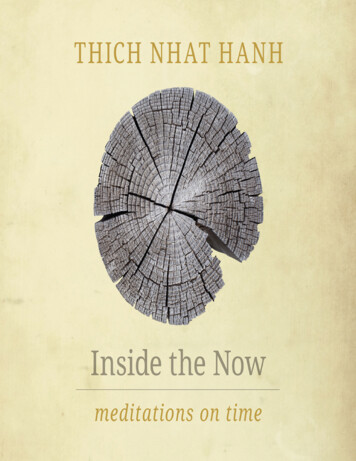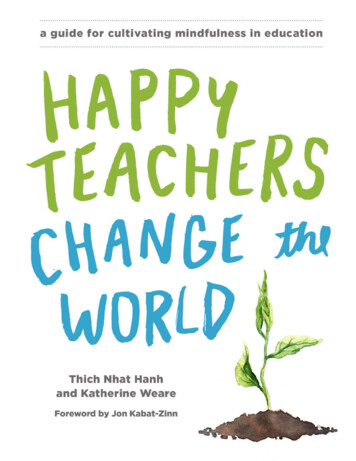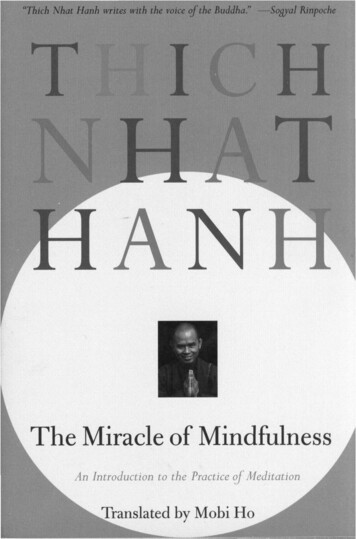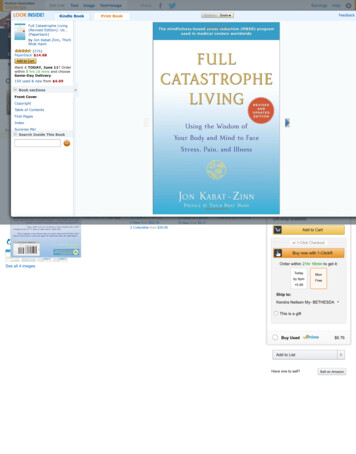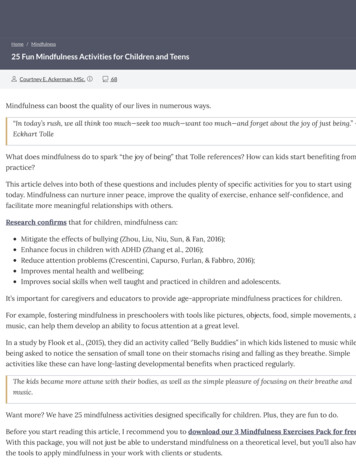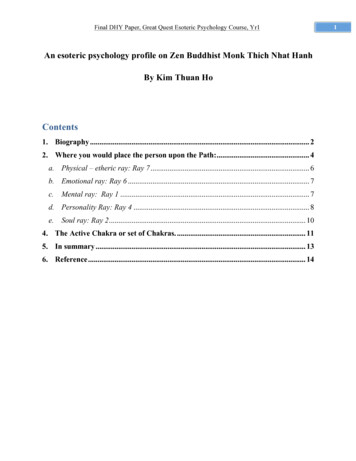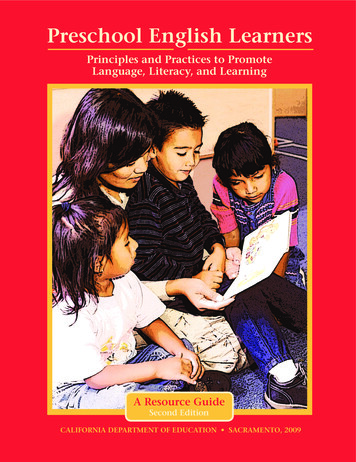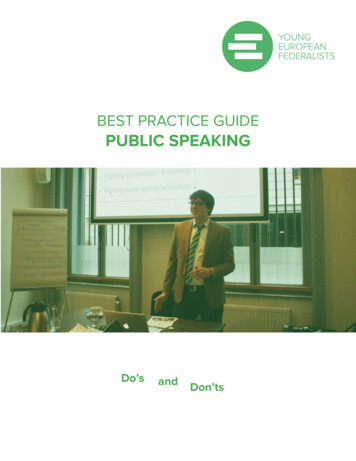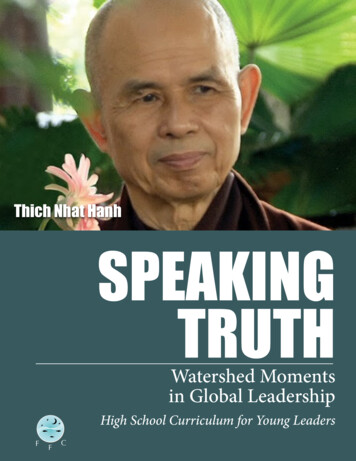
Transcription
Thich Nhat HanhSPEAKINGTRUTHWatershed Momentsin Global LeadershipHigh School Curriculum for Young LeadersFFC Speaking TruthFFCCurriculum – Thich Nhat HanhPage 1 of 12
The teacher, writer and peace activist, Thich NhatHanh was born in 1926 in Thura Thien, CentralVietnam. Thich Nhat Hanh, entered the Zenmonastery of Tu Hieu in Vietnam at the age of sixteen. He became a Buddhist monk in 1949 while attending the Baó Quoc Buddhist Institute. 1Soon after his ordination he decided to leave hismonastery in order to support those touched by theVietnam Conflict. “The essence of nonviolence is love.Out of love and the willingness to act selflessly, strategies, tactics, and techniques for a nonviolent struggle arise naturally Nonviolent action, born of the awareness of suffering and nurtured by love, is the most effective wayto confront adversity.” 2BackgroundLeaving the monastery allowed Nhat Hanh to express his ideas against the war. After leaving hismonastery he settled a deserted temple in Saigon inorder to help the others suffering from the warwhile pursuing his religious practices and meditation.3 This gave rise to his Engaged Buddhismmovement, which in collaboration with Christiangroups around the world set the goal to overcomeviolence and war.4The 1960’s brought Thich Nhat Hanh to PrincetonUniversity to study comparative religion.5 Following his time at Princeton, NhatHanh founded the Buddhist University of Van Hanh and the School of Youth forSocial Service (affiliated with the University of Hanh). The intended goal of these1Taylor, Philip. Modernity and Re-enchantment: Religion in Post-revolutionary Vietnam. Singapore: Institute of Southeast Asian Studies, 2007. Print.2Thich Nhat Hanh, Love in Action: Writings on Nonviolent Social Change (Berkeley, CA.: Parallax Press,1993) [originally 1969], p. 39.3Queen, Christopher S., and Sallie B. King. Engaged Buddhism: Buddhist Liberation Movements in Asia.Albany: State U of New York, 1996. Print, p.322.4Hạnh, Nhất, and Arnold Kotler. Peace Is Every Step: The Path of Mindfulness in Everyday Life. NewYork, NY: Bantam, 1991. Print, p.10.5Hạnh, Nhất, and Arnold Kotler. Peace Is Every Step: The Path of Mindfulness in Everyday Life. NewYork, NY: Bantam, 1991. Print, p.10.FFC Speaking TruthCurriculum – Thich Nhat HanhPage 2 of 12
institutions was to inspire individuals to fight violence through Buddhist principles.6“Should we continue to practice in our monasteries, or should we leave the meditation halls in order to help the people who were suffering under the bombs? Aftercareful reflection, we decided to do both – to go out and help people and to do so inmindfulness. We called it Engaged Buddhism.” 767Thich Nhat Hanh. “Plum Village.” Web. 18 May 2016.Thich Nhat Hanh, Peace is Every Step (New York: Bantam Books, 1991), p. 91.FFC Speaking TruthCurriculum – Thich Nhat HanhPage 3 of 12
Thich Nhat Hanh returned to Vietnam to join agroup of monks determined to bring an end to warafter the fall of the Diem regime.8 This non-violentresistance movement was inspired by Gandhi andBuddhist religious practices. Nhat Hanh’s group developed a range of non-violent forms of struggle, including fasting and using literature and the arts asways to challenge oppression. 9Role of FaithIn 1965 Nhat Hanh founded the Tiep Hien Orderbased on Engaged Buddhism principles in order toaddress the sufferings experienced by the Vietnamese during the war.10“Engaged Buddhism” teaches a cyclical process. By understanding the true natureof self, we better understand the true nature of society; then we use that enhancedunderstanding to gain an even deeper understanding of self, which leads to deeper understanding of society, and so on. Ultimately, we understand that self andsociety have no separate existence.Awareness of interdependence makes it immediately evident that each of usshares responsibility for all that happens and will happen: "There is no phenomenon in the universe that does not immediately concern us." As soon as werecognize that responsibility, we are moved to act to improve the situation Weare all part of the same human process, all driven by the same processes. Changing that process means changing both situation and self: “Meditation is to seedeeply into things, to see how we can change, how we can transform our situation. To transform our situation is also to transform our minds. To transform ourminds is also to transform our situation, because the situation is mind, and mindis situation.”Since the individual and society “inter-are,” each must nourish the other, or bothwill wither. (http://spot.colorado.edu/ chernus/NonviolenceBook/ThichNhatHanh.htm)Hạnh, Nhất, and Arnold Kotler. Peace Is Every Step: The Path of Mindfulness in EverydayNew York, NY: Bantam, 1991. Print.8Life.Excerpted from ds/2012/01/08 Thich Nhat Han h MLK1.pdf910Thich Nhat Hanh, Interbeing: Commentaries on the Tiep Hien Precepts (Berkeley: Parallax Press,1987), p. 5.FFC Speaking TruthCurriculum – Thich Nhat HanhPage 4 of 12
The Tiep Hien Order gained notoriety when several Buddhist monks practiced selfimmolation (set themselves on fire).11 This dramatic action was misunderstood inthe West as a rash act of suicide that could not possibly bring about change, orpromote neutrality and peace. Thich Nhat Hanh decided to write an open letter toMartin Luther King Jr. to explain the essence of self-immolation and within the letter, he asked Martin Luther King Jr. to speak publicly against the US-Vietnam war.The Vietnamese monk, by burning himself, say with all his strengh [sic] and determination that he can endure the greatest of sufferings to protect his people. Butwhy does he have to burn himself to death? The difference between burning oneself and burning oneself to death is only a difference in degree, not in nature. Aman who burns himself too much must die. What he really aims at is the expression of his will and determination, not death. In the Buddhist belief, life is notconfined to a period of 60 or 80 or 100 years: life is eternal. Life is not confined tothis body: life is universal. To express will by burning oneself, therefore, is not tocommit an act of destruction but to perform an act of construction, i.e., to sufferand to die for the sake of one's people. This is not suicide.(http://www.aavw.org/special features/letters thich abstract02.html, http://www.aavw.org/special features/letters thich abstract02.html)Martin Luther King Jr. referred to Nhat Hanh as “ an apostle of peace and nonviolence.”12 He was so inspired by him that in 1967 King nominated Thich nhat Hanhfor the Nobel Peace Prize. By following Buddhist practices, Nhat Hanh was able tofind strength and calmness in order to fight for what he thought was right, nonviolence.Worth, Robert F. "How a Single Match Can Ignite a Revolution." The New York Times. The New YorkTimes, 2011. Web. 23 May 2016.1112"Thich Nhat Hanh and Martin Luther King's Dream Comes True in Mississippi." PlumVillage.FFC Speaking TruthCurriculum – Thich Nhat HanhPage 5 of 12
The nonviolent peace movement of Vietnamesemonks against the Vietnam War became a movement of global dimensions. Thich Nhat Hanh travelled to the West to preach and convince people thatthe war was immoral. He was inspired by the philosophy of non-violence of Gandhi and the AfricanAmerican Civil Rights Movement. In kind MartinLuther King Jr. was inspired by Nhat Hanh’s approach to non-violence.Role ModelBecause of his position against the war in Vietnam hewas forbidden to return to his country. Thich Nhat Hanh settled in France in theearly seventies and founded Plum Village in 1982. Plum Village is a Buddhist meditation center where all people are welcome. Plum Village was created to provide aplace for people to connect with themselves, each other and the environment.Mindfulness is a foundational practice at Plum Village. Thich Nhat Hanh believesthat, “ we can learn to live happily in the present moment—the only way to trulydevelop peace, both in one’s self and in the world.” 13Works Cited:Hạnh, Nhất, and Arnold Kotler. Peace Is Every Step: The Path of Mindfulness inEveryday Life. New York, NY: Bantam, 1991. Print.Hạnh, Nhất, and Arnold Kotler. Peace Is Every Step: The Path of Mindfulness inEveryday Life. New York, NY: Bantam, 1991. Print.King, Robert Harlen. Thomas Merton and Thich Nhat Hanh: Engaged Spiritualityin an Age of Globalization. New York: Continuum, 2001. Print.King, Sallie B. Socially Engaged Buddhism. Honolulu: U of Hawai’i, 2009. Print.“Monastic Practice Centres.” Plum Village. Accessed May 25, 2016.Queen, Christopher S., and Sallie B. King. Engaged Buddhism: Buddhist LiberationMovements in Asia. Albany: State U of New York, 1996. Print.Taylor, Philip. Modernity and Re-enchantment: Religion in Post-revolutionaryVietnam. Singapore: Institute of Southeast Asian Studies, 2007. Print.Hạnh, Nhất, and Arnold Kotler. Peace Is Every Step: The Path of Mindfulness inEveryday Life. New York, NY: Bantam, 1991. Print.13"Thich Nhat Hanh." Plum Village. Web. 18 May 2016.FFC Speaking TruthCurriculum – Thich Nhat HanhPage 6 of 12
Thich Nhat Hanh, Interbeing: Commentaries on the Tiep Hien Precepts (Berkeley:Parallax Press, 1987), p. 5.Thich Nhat Hanh, Peace is Every Step (New York: Bantam Books, 1991), p. 91.Thich Nhat Hanh, Love in Action: Writings on Nonviolent Social Change (Berkeley,CA.: Parallax Press, 1993) [originally 1969], p. 39.“Thich Nhat Hanh.” Plum Village. Web. 18 May 2016.“Thich Nhat Hanh and Martin Luther King’s Dream Comes True in Mississippi.”Plum Village.Worth, Robert F. “How a Single Match Can Ignite a Revolution.” The New YorkTimes. The New York Times, 2011. Web. 23 May 2016.FFC Speaking TruthCurriculum – Thich Nhat HanhPage 7 of 12
Content ObjectivesStudents will examine the experiences in their livesthat have shaped their faith.Students will create visuals of their faith journeysand share their “maps” with the class.MaterialsPaper (11x14)SpiritualMapsColored pencils, crayons, markersSynopsis of LessonBegin by asking students to reflect on their experiences with religion and faith.Perhaps have them sit back, close their eyes and think about their earliest memoriesto present ones about the role of religion, belief in their lives. Then have studentsget up and put themselves in a line one end representing those who believe in aGod concept and consider themselves religious, the other end for those who consider themselves atheists or humanists (making sure they understand the terms).Explain that this is a spectrum and they should put themselves in the location thatbest represents their beliefs.Ask students to explain why they have placed themselves where they have in theline.After the discussion is over students should return to their seats. They will now becreating Spiritual Maps. You will be asking them to capture those moments thathave shaped what they believe in the form of a map (journey). I introduce this activity by sharing with students the map that I drew to capture my spiritual journey.Their journeys will all begin with their births and they end in this moment. Askstudents to consider what the path looks like that they are on, is it a road, river,mountain, what stops have there been along the way, what people and places havebeen part of their journey.Once students have completed their maps have each member of the class share theirjourney with their peers.FFC Speaking TruthCurriculum – Thich Nhat HanhPage 8 of 12
One of the fundamental teachings of Thich NhatHanh is mindfulness.“Many people are alive but don't touch the miracle ofbeing alive.”“Only this actual moment is on)MindfulnessThe following exercises can be used to introduce theconcept of mindfulness.AutopilotBegin by asking students to make a list of all the things they do, without reallythinking about doing them. For example: brushing our teeth, eating, walking toclass. All of these activities are being done on autopilot. Then pass out chocolate(white chocolate and raisins can be used as well for the next activity). Move on toExplore Mindfulness.Explore MindfulnessPass out small pieces of chocolate to each participant. (I use Hershey kisses). Have eachperson unwrap the chocolate and place it onthe desk in front of him/her. Check in, askingparticipants to sit back in their chairs, placetheir feet flat on the ground and begin to focus on their breathing. Once the group isready have individuals pick up their chocolate, place it in their mouths and closetheir eyes. Remind them to focus on the act of eating the chocolate, notice the texture, smell, and flavor of the experience. When an individual finishes his/her chocolate he/she should open their eyes. Once everyone’s eyes are open ask the groupwhat they noticed about the experience.FFC Speaking TruthCurriculum – Thich Nhat HanhPage 9 of 12
An Introduction to Mindful Meditation (The Science)Just 10 minutes a day devoted to mindfulness can be transformative. Think aboutthat 10 minutes; that is less time than most people spend on their hair.The science behind the impact of meditation:Meditative mindfulness practices have been shown to positively alter the structureand neural patterns in the brain and strengthen the brain regions associated withheightened sensory processing and empathetic response.A study performed at Stanford found that an 8-week mindfulness course reducedthe reactivity of the amygdala and increased activity in areas of the prefrontal cortexthat help regulate emotions, subsequently reducing stress. Similarly, researchersfrom Harvard University discovered corresponding changes in the physical structure of the brain with a similar meditation course; there was a lower density of neurons in the amygdala and greater density of neurons in areas involved in emotionalcontrol - evidence that meditation served as a realistic and maintainable stressmanagement technique. esstraining-has-positive-health-benefits/)Ted TalkThe following Ted Talk by Andy Puddicombe is an excellent introduction to mindful meditation. https://www.ted.com/talks/andy puddicombe all it takes is 10 mindful minutes?language enMindfulness expert Andy Puddicombe describes the transformative power of doingjust that: Refreshing your mind for 10 minutes a day, simply by being mindful andexperiencing the present moment.5 Mindfulness Exercises You Can Try TodayPocket Mindfulness by Alfred JamesMost of us don’t have five minutes to sit down and relax, let alone 30 minutes ormore for a meditation session, but it’s essential for our wellbeing to take a few minutes each day to cultivate mental spaciousness and achieve a positive mind-bodybalance.Try using these simple, practical mindfulness exercises to empty your mind andfind some much-needed calm amidst the madness of a hectic day.FFC Speaking TruthCurriculum – Thich Nhat HanhPage 10 of 12
1.One-Minute Breathing This exercise can be done anywhere at any time,standing up or sitting down. All you have to do is focus on your breath forjust one minute. Start by breathing in and out slowly, holding your breath fora count of six once you’ve inhaled. Then breathe out slowly, letting the breathflow effortlessly out back into the atmosphere.Naturally your mind will try and wander, simply notice these thoughts, letthem be as they are and return to watching your breath.Purposefully watch your breath as it enters and exits the body. Spend oneminute being fully present with your breathe.2.Mindful Observation This exercise is simple but incredibly powerful. It isdesigned to connect us with the beauty of the natural environment, which iseasily missed when we’re rushing around in the car or hopping on and offtrains on the way to work.Pick something from nature within your immediate environment and focuson watching it for a minute or two. This could be a flower or an insect, or theclouds or the moon.Don’t do anything except notice the thing you are looking at. But really notice it. Look at it as if you are seeing it for the first time.Visually explore every aspect of this glorious gift of the natural world. Allowyourself to be consumed by its presence and possibilities. Allow yourself toconnect with its role and purpose in the world.3.Touch Points This exercise is designed to make us appreciate our lives byslowing the pace. This opens the gate to purer awareness and the ability totruly rest in the moment for a while.Think of something that happens every day more than once. Something youtake for granted, like opening a door for example. At the very moment youtouch the doorknob to open the door, allow yourself to be completely mindful of where you are, how you feel and what you are doing. Similarly, themoment you open your computer to start work, take a moment to appreciatethe hands that let you do this, and the brain that will help you use the computer.The cues don’t have to be physical ones. It could be that every time you thinksomething negative you take a mindful moment to release the negativethought, or it could be that every time you smell food you take a mindfulmoment to rest in the appreciation of having food to eat.FFC Speaking TruthCurriculum – Thich Nhat HanhPage 11 of 12
Choose a touch point that resonates with you today. Instead of going throughthe motions on autopilot, stop and stay in the moment for a while and rest inthe awareness of this blessed daily activity.4.Fully Experience a Regular Routine The intention of this exercise is to cultivate contentedness in the moment, rather than finding yourself caught upin that familiar feeling of wanting something to end so that you can get on todoing something else. It might even make you enjoy some of those boringdaily chores too!Take a regular routine that you find yourself “just doing” without reallynoticing your actions. For example, when cleaning your house, pay attentionto every detail of the activity.Rather than treat this as a regular chore, create an entirely new experience bynoticing every aspect of your actions. Feel and become the motion of sweeping the floor, notice the muscles you use when scrubbing the dishes, observethe formation of dirt on the windows and see if you can create a more efficient way of removing it. Be creative and find new experiences within thisfamiliar routine.5.A Game of Fives In this mindfulness exercise, all you have to do is notice fivethings in your day that usually go unnoticed and unappreciated. These can bethings you hear, smell, feel or see.For example, you might see the walls of your front room every day, youmight hear the birds in the tree outside in the morning, you might the chill inthe air on a winter morning, but are you truly appreciating these things andthe connections they have with your life and the world at large?Let your creative mind explore the wonder, impact and possibilities theseusually unnoticed things have on your life. Allow yourself to fall awake intothe world for a while and fully experience the environment that encapsulatesyour daily routine.FFC Speaking TruthCurriculum – Thich Nhat HanhPage 12 of 12
!e 1960’s brought !ich Nhat Hanh to Princeton University to study comparative religion.5 Following his time at Princeton, Nhat Hanh founded the Buddhist University of Van Hanh and the School of Youth for Social Service (affiliated with the University of Hanh). !e intended goal of these 1 T
